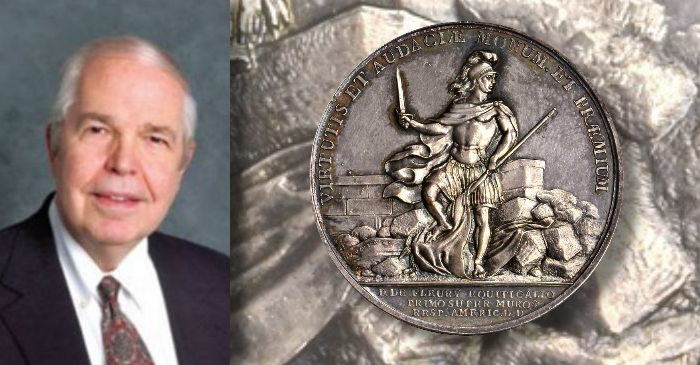
By Lianna Spurrier for CoinWeek …..
World War II affected coins almost everywhere around the world.
In the United States, the most dramatic effect that the war had on our coinage was the steel penny. The composition of our nickels changed as well, but that wasn’t an immediately noticeable change in the appearance of the coin. Both changes are well-known by collectors today.
But in other countries, the coinage was changed in much stranger and farther reaching ways than steel cents and partially-silver nickels. This article presents a sampling of the fascinating coin experiments conducted abroad.
The World War II Clay and Cardboard Coins of Japan
Japan got very creative with alternative materials, both at home and in some of the occupied territories.
The composition of the Japanese 1 sen coin began to change in 1938. Previously produced in brass, the copper percentage was reduced to create a bronze coin. Later the same year, they released a significantly smaller and lighter 1 sen coin struck in aluminum. This composition stuck and was used through 1943, though the size was reduced again in 1941. Between 1938 and 1941, the denomination shrunk from 23mm to 16mm, and from 3.75g to 0.65g.

The most dramatic change, however, occurred in 1945. As the end of WWII approached, Japan was suffering from a serious shortage of metals – wasting them on coins was not an option. Instead, they tested making experimental 1 sen coins from baked clay. They appeared red, and were produced by private companies for the mint.
Some patterns were made for other denominations, but the 1 sen clay coins are the only ones that may have circulated. According to Krause’s Standard Catalog of World Coins, they circulated for just a few days before the war ended and were quickly withdrawn. No other English-language source has been found that claims they were ever put into circulation, but it is known that significantly more 1 sen clay coins were made than any other of the test denominations. If the war had continued, they would have circulated.
Japan also minted coins for many external territories, and some of these were affected as well. The region known as Manchukuo (Manchuria), which now makes up the northeast section of China, was controlled by Japan from 1931 to 1945.
The Japanese Empire had been minting coins for the territory since 1932, but when metals became scarce, Manchukuo’s coins were an early casualty. In 1944, Japan began producing the territory’s 1 fen and 5 fen coins in a reddish fiber that resembled corrugated cardboard. These experimental coins did circulate, and while mintage numbers aren’t known, they’re not overly expensive to purchase today.
Together, these instances are some of the very few non-metallic coins that have circulated in the modern world, though none seems as though it would hold up very well.
The Wartime Tombac Coins of Canada
Like the United States, Canada also had to adjust the composition of their nickels, but their change wasn’t nearly as subtle. In late 1942, Canada switched to a brass alloy called tombac, which was a copper-gold color. Hoping to make them easier to distinguish from pennies, they made the nickels 12-sided instead of round.

But this wasn’t enough. When not paying attention, people still had too much trouble separating the new nickels from pennies.
In 1943, Canada changed the reverse design from the usual beaver to a large V behind a torch. The V was intended to stand for both the denomination and Victory. In addition, the normal nickels had a beaded border; they changed the shape and size of the beads to spell out “We win when we work willingly” in Morse code.
The same design was used through 1945, but they changed the composition in 1944 to steel, plated first in nickel and then steel. This gave them a slightly blue-tinted silver color that looked similar to nickel. The change was welcomed by the Canadian public, finally putting the complaints about tombac to bed. The Royal Canadian Mint did have some trouble with the chrome-plating process, and a few were accidentally released without chrome. Those with the chrome plating scratch very easily.
After the war, Canada returned to the normal nickel alloy and beaver design, but the coin remained 12-sided until 1964.
The World War II Zinc and Steel Coins of Belgium

Belgium was occupied by Germany from 1940 until 1944, when it was liberated by Allied forces. During the occupation, their previously silver coins were withdrawn from circulation and replaced with zinc variations.
The interesting change came in 1944, after liberation. The United States used leftover steel planchets, originally intended to produce steel cents in 1944, to strike 2 franc coins to circulate in Free Belgium. The 2 franc denomination had been discontinued and removed from circulation during the German occupation. However, the steel coins were minted only in 1944, after which no 2 franc coins were struck.
It seems as though the Belgians may have disliked the steel coins as much as Americans did.
Altered Wartime Coinage in Europe at Large
Like in Belgium, zinc was used for the coinage in many countries under German control.
In the Netherlands, all coins valued higher than 25 cents were discontinued, and all that remained were redesigned and issued in zinc. Previously, they minted coins in an array of metals, such as bronze and silver. All of these disappeared and were replaced by the dark and dull zinc coins.
With a few exceptions, most of the coins of Denmark were also replaced by zinc, the smaller denominations of which remained through the 1970s. Many of Norway’s coins were issued in zinc, though the smaller denominations appeared in iron. The area was particularly rich in the metal, so it made sense to use it for coinage.
Poland, the invasion of which ignited World War II, stopped officially issuing coins altogether after 1939. That year, however, limited quantities were produced in iron and zinc. Two denominations – the 10 and 20 grosz – were struck using old dies, dated 1923. The original 1923 issues were made in nickel, so the two are easily distinguishable.
France was controlled by a puppet state run by Germany, the Vichy French State, which issued coinage with new designs. On the 1 franc, for example, an artistic portrait was replaced by a labrys, or double-bladed axe. As for composition, the “experimental” coins used both zinc and aluminum.
However, even European countries that weren’t controlled by Germany made drastic changes to their coinage systems in response to the war. In Italy, previously bronze coins were made in aluminum-bronze and higher denominations in stainless steel. The same metals were used in Albania, which was occupied by Italy, though the end of the war. After liberation, Albania switched to zinc.
Iceland remained neutral for most of the war, but nickel shortages led them to stop producing 10 aurar and 25 aurar coins in 1940. In 1942, both denominations were issued in zinc, and then discontinued altogether until 1946. Switzerland, another neutral country, had to replace their bronze coins with zinc, although no modifications were made to silver or nickel denominations.
Compared to many of these places, the changes that took place in America were minor. World War II did not cause our coins to be redesigned entirely; they didn’t change size, and we certainly didn’t have any non-metallic pieces (though experimental glass pennies were cut).
Other countries faced an entire overhaul of their coinage system within a year or two, but a steel penny was far too much trouble for Americans to deal with.
* * *
The post How World War II Created Strange and Unusual Coins appeared first on CoinWeek: Rare Coin, Currency, and Bullion News for Collectors.
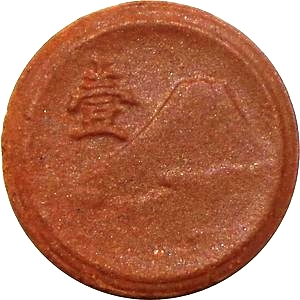

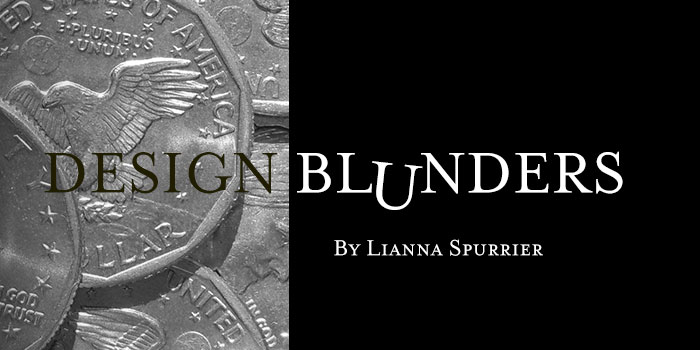
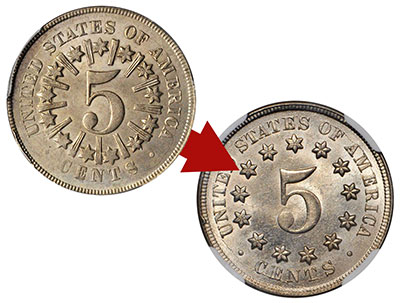 The rays on the reverse were part of the problem. There was little space between each ray and its neighboring stars, making it a particularly problematic part of the coin. They were removed in part to help the dies last longer.
The rays on the reverse were part of the problem. There was little space between each ray and its neighboring stars, making it a particularly problematic part of the coin. They were removed in part to help the dies last longer.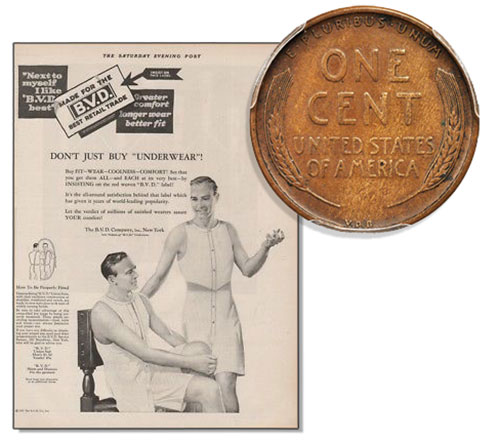 The initials “VDB”, on the bottom reverse of the coin, were seen as too bold and made many think of Brenner as conceited. In addition, according to the Des Moines News, some people mistook the initials for the trademark of an underwear brand – BVD.
The initials “VDB”, on the bottom reverse of the coin, were seen as too bold and made many think of Brenner as conceited. In addition, according to the Des Moines News, some people mistook the initials for the trademark of an underwear brand – BVD.
 The verdict? Not so much. In 1988, the Colorado Springs Gazette quoted Michael Brown, Spokesman for the
The verdict? Not so much. In 1988, the Colorado Springs Gazette quoted Michael Brown, Spokesman for the 